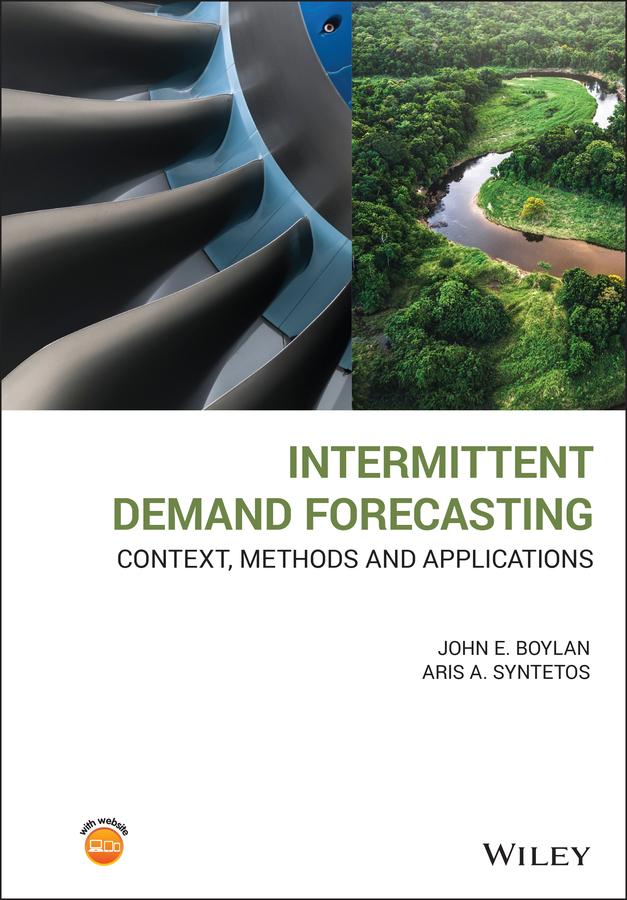Intermittent Demand Forecasting: Context, Methods and Applications Syntetos
Visit to download the full and correct content document: https://ebookmass.com/product/intermittent-demand-forecasting-context-methods-an d-applications-syntetos/

More products digital (pdf, epub, mobi) instant download maybe you interests ...

Intermittent Demand Forecasting: Context, Methods and Applications 1st Edition Aris A. Syntetos
https://ebookmass.com/product/intermittent-demand-forecastingcontext-methods-and-applications-1st-edition-aris-a-syntetos/

Applied economic forecasting using time series methods
Ghysels
https://ebookmass.com/product/applied-economic-forecasting-usingtime-series-methods-ghysels/

Forecasting with Artificial Intelligence: Theory and Applications Mohsen Hamoudia
https://ebookmass.com/product/forecasting-with-artificialintelligence-theory-and-applications-mohsen-hamoudia/

Bioinformatics: Methods and Applications Dev Bukhsh
Singh
https://ebookmass.com/product/bioinformatics-methods-andapplications-dev-bukhsh-singh/

Rheology: Concepts, Methods, and Applications
Alexander Y. Malkin
https://ebookmass.com/product/rheology-concepts-methods-andapplications-alexander-y-malkin/

Tribology of Graphene: Simulation Methods, Preparation Methods, and Their Applications Oleksiy V. Penkov
https://ebookmass.com/product/tribology-of-graphene-simulationmethods-preparation-methods-and-their-applications-oleksiy-vpenkov/

Seismic Imaging Methods and Applications for Oil and Gas Exploration
Yasir Bashir
https://ebookmass.com/product/seismic-imaging-methods-andapplications-for-oil-and-gas-exploration-yasir-bashir/

Solid State NMR: Principles, Methods, and Applications
Klaus Müller
https://ebookmass.com/product/solid-state-nmr-principles-methodsand-applications-klaus-muller/

Electrochemical Methods: Fundamentals and Applications, 2nd Edition – Ebook PDF Version
https://ebookmass.com/product/electrochemical-methodsfundamentals-and-applications-2nd-edition-ebook-pdf-version/

Table of Contents
Cover
Title Page
Copyright
Dedication
Preface
Glossary
About the Companion Website
1 Economic and Environmental Context
1.1 Introduction
1.2 Economic and Environmental Benefits
1.3 Intermittent Demand Forecasting Software
1.4 About this Book
1.5 Chapter Summary
Technical Note
2 Inventory Management and Forecasting
2.1 Introduction
2.2 Scheduling and Forecasting
2.3 Should an Item Be Stocked at All?
2.4 Inventory Control Requirements
2.5 Overview of Stock Rules
2.6 Chapter Summary
Technical Notes
3 Service Level Measures
3.1 Introduction
3.2 Judgemental Ordering
3.3 Aggregate Financial and Service Targets
3.4 Service Measures at SKU Level
3.5 Calculating Cycle Service Levels
3.6 Calculating Fill Rates
3.7 Setting Service Level Targets
3.8 Chapter Summary
Technical Note
4 Demand Distributions
4.1 Introduction
4.2 Estimation of Demand Distributions
4.3 Criteria for Demand Distributions
4.4 Poisson Distribution
4.5 Poisson Demand Distribution
4.6 Incidence and Occurrence
4.7 Poisson Demand Incidence Distribution
4.8 Bernoulli Demand Occurrence Distribution
4.9 Chapter Summary
Technical Notes
5 Compound Demand Distributions
5.1 Introduction
5.2 Compound Poisson Distributions
5.3 Stuttering Poisson Distribution
5.4 Negative Binomial Distribution
5.5 Compound Bernoulli Distributions
5.6 Compound Erlang Distributions
5.7 Differing Time Units
5.8 Chapter Summary
Technical Notes
6 Forecasting Mean Demand
6.1 Introduction
6.2 Demand Assumptions
6.3 Single Exponential Smoothing (SES)
6.4 Croston's Critique of SES
6.5 Croston's Method
6.6 Critique of Croston's Method
6.7 Syntetos–Boylan Approximation
6.8 Aggregation for Intermittent Demand
6.9 Empirical Studies
6.10 Chapter Summary
Technical Notes
7 Forecasting the Variance of Demand and Forecast Error
7.1 Introduction
7.2 Mean Known, Variance Unknown
7.3 Mean Unknown, Variance Unknown
7.4 Lead Time Variability
7.5 Chapter Summary
Technical Notes
8 Inventory Settings
8.1 Introduction
8.2 Normal Demand
8.3 Poisson Demand
8.4 Compound Poisson Demand
8.5 Variable Lead Times
8.6 Chapter Summary
Technical Notes
9 Accuracy and Its Implications
9.1 Introduction
9.2 Forecast Evaluation
9.3 Error Measures in Common Usage
9.4 Criteria for Error Measures
9.5 Mean Absolute Percentage Error and its Variants
9.6 Measures Based on the Mean Absolute Error
9.7 Measures Based on the Mean Error
9.8 Measures Based on the Mean Square Error
9.9 Accuracy of Predictive Distributions
9.10 Accuracy Implication Measures
9.11 Chapter Summary
Technical Notes
10 Judgement, Bias, and Mean Square Error
10.1 Introduction
10.2 Judgemental Forecasting
10.3 Forecast Bias
10.4 The Components of Mean Square Error
10.5 Chapter Summary
Technical Notes
11 Classification Methods
11.1 Introduction
11.2 Classification Schemes
11.3 ABC Classification
11.4 Extensions to the ABC Classification
11.5 Conceptual Clarifications
11.6 Classification Based on Demand Sources
11.7 Forecasting‐based Classifications
11.8 Chapter Summary
Technical Notes
12 Maintenance and Obsolescence
12.1 Introduction
12.2 Maintenance Contexts
12.3 Causal Forecasting
12.4 Time Series Methods
12.5 Forecasting in Context
12.6 Chapter Summary
Technical Notes
13 Non‐parametric Methods
13.1 Introduction
13.2 Empirical Distribution Functions
13.3 Non‐overlapping and Overlapping Blocks
13.4 Comparison of Approaches
13.5 Resampling Methods
13.6 Limitations of Simple Bootstrapping
13.7 Extensions to Simple Bootstrapping
13.8 Chapter Summary
Technical Notes
14 Model‐based Methods
14.1 Introduction
14.2 Models and Methods
14.3 Integer Autoregressive Moving Average (INARMA) Models
14.4 INARMA Parameter Estimation
14.5 Identification of INARMA Models
14.6 Forecasting Using INARMA Models
14.7 Predicting the Whole Demand Distribution
14.8 State Space Models for Intermittence
14.9 Chapter Summary
Technical Notes
15 Software for Intermittent Demand
15.1 Introduction
15.2 Taxonomy of Software
15.3 Framework for Software Evaluation
15.4 Software Features and Their Availability
15.5 Training
15.6 Forecast Support Systems
15.7 Alternative Perspectives
15.8 Way Forward
15.9 Chapter Summary
Technical Note
ReferencesReferences
Author Index
Subject Index
End User License Agreement
List of Tables
Chapter 3
Table 3.1 Order comprising five order lines.
Table 3.2 Distribution of demand over one week.
Table 3.3 Probability distribution of total demand over two weeks.
Table 3.4 Cumulative distribution of total demand over two weeks.
Table 3.5 Distribution of total demand over two weeks conditional on non‐zero...
Table 3.6 Fill rates per time period.
Table 3.7 Distribution of lumpy demand over one week.
Table 3.8 Traditional fill rate calculation ( and ; ).
Table 3.9 Sobel's fill rate calculation ( , , ).
Chapter 4
Table 4.1 Triangular distribution example.
Table 4.2 Poisson probabilities ( ).
Table 4.3 Calculation of chi‐square goodness of fit statistic.
Table 4.4 Example of demand incidences.
Table 4.5 Weekly demand data.
Table 4.6 Sequence of demand occurrences (1) and non‐occurrences (0).
Table 4.7 Observed and estimated order incidences over four weeks.
Table 4.8 Critical values of the chi‐square distribution for degrees of freed...
Chapter 5
Table 5.1 Poisson ( ) and stuttering Poisson ( and probabilities (prob) an...

Table 5.2 Calculation of negative binomial probabilities ( and ).

Table 5.3 Percentages of SKUs with strong fit (demand per period).
Table 5.4 Percentages of SKUs with strong fit (lead time demand).
Table 5.5 Variables to be forecasted for four demand distributions.
Table 5.6 ‘Stars and bars’ diagrams.
Chapter 6
Table 6.1 SES bias (issue points only, ) as a percentage of average demand.
Table 6.2 Intermittent demand series (first eight periods).
Table 6.3 Series of demand sizes and demand intervals.
Table 6.4 Intermittent demand series (first 10 periods).
Table 6.5 Intermittent series (after demand occurrence in period zero).
Table 6.6 Croston's bias as a percentage of average demand.
Table 6.7 Bias correction factors.
Table 6.8 Bias of SES ( ) as a percentage of average demand conditional on de...
Chapter 7
Table 7.1 Updating of mean and variance using SES.
Table 7.2 Updating of variance over protection interval: scaled and direct.
Table 7.3 Distributions of demand over gamma distributed lead times.
Chapter 8
Table 8.1 Safety factors for CSL targets, normal demand.
Table 8.2 Safety factors for fill rate (FR) targets, normal demand.
Table 8.3 Asymmetric effect of under‐ and over‐forecasting.
Table 8.4 Adjusted safety factors for cycle service levels.
Table 8.5 Cycle service level for Poisson demand ((R+L) ).
Table 8.6 Fill rate for Poisson distributed demand.
Table 8.7 Cycle service levels for stuttering Poisson distributed demand.
Table 8.8 Weighted cumulative probabilities.
Table 8.9 Adjusted safety factors for fill rates.
Table 8.10 component calculations for Poisson distributed demand.
Table 8.11 calculations for Poisson distributed demand.
Table 8.12 Fill rate calculations for Poisson demand.
Table 8.13 component calculations for stuttering Poisson demand.
Chapter 9
Table 9.1 Mean error, mean square error, mean absolute error, and mean absolu...
Table 9.2 Forecast value added (FVA) example.
Table 9.3 MAPEFF and sMAPE for intermittent demand.
Table 9.4 MAE : Mean ratios for multiple series.
Table 9.5 Mean absolute error for zero forecasts.
Table 9.6 Mean error (ME) and mean absolute error (MAE).
Table 9.7 Scaled mean error for multiple series.
Chapter 10
Table 10.1 Reported usage of forecast methods in practice.
Table 10.2 Judgemental adjustments: effect on cycle service levels.
Table 10.3 Cumulative forecast error (CFE).
Table 10.4 Mean square error (frequent zeroes).
Chapter 13
Table 13.1 Cumulative frequency percentages.
Table 13.2 Three‐month overlapping blocks (OB) and non‐overlapping blocks (NO...
Table 13.3 Resampling from previous observations.
Table 13.4 VZ resampling method ( ).
Table 13.5 Most recent 10 observations from Table 13.2.
Table 13.6 Conditional probabilities of demand occurrence.
Table 13.7 Simple bootstrapping with Markov chain extension..

Table 13.8 Theta function calculation ( , ), overlap of one period.
Chapter 14
Table 14.1 INAR(1) process example.
Table 14.2 INMA(1) process example.
Table 14.3 Four simplest INARMA models.
Table 14.4 Empirical evidence on model identification.
Table 14.5 Conditional probabilities of demand at time ( ) given demand at t...

Table 14.6 Cumulative conditional probabilities at time ( ) given demand at ...

Table 14.7 Cumulative probabilities of demand over two periods ( ), given dem...

Chapter 15
Table 15.1 Software implementation.
List of Illustrations
Chapter 1
Figure 1.1 Intermittent and lumpy demand.
Chapter 2
Figure 2.1 Bill of materials (BoM) example.
Figure 2.2 Periodic review and continuous review systems.


Figure 2.3 Continuous review and policies for unit sized transactions.
Figure 2.4 Periodic review policy.
Chapter 3

Figure 3.1 Comparison of CSL and .
Figure 3.2 Exchange curve.
Figure 3.3 RightStock Inventory Strategist.
Chapter 4
Figure 4.1 Monthly demand time series for an automotive SKU.
Figure 4.2 Demand frequencies for an automotive SKU.
Figure 4.3 Demand relative frequencies with triangle superimposed.
Figure 4.4 Actual relative frequencies and triangular probabilities.
Figure 4.5 Poisson distribution for varying mean ( ) values.
Figure 4.6 Poisson probabilities and actual relative frequencies.
Figure 4.7 Variance and mean of weekly order frequencies.
Chapter 5
Figure 5.1 Geometric distribution ( ).

Figure 5.2 Standard deviation and mean of demand sizes.
Source: Johnston et ...
Figure 5.3 Frequency distribution of order sizes. Source: Johnston et al. 20...
Figure 5.4 Logarithmic distribution ( = 0.33, 0.66, 0.99).
Figure 5.5 Exponential distributions. (a) Probability density; (b) Cumulativ...
Figure 5.6 Erlang distributions.
Figure 5.7 Normal distribution (poor approximation).
Figure 5.8 Normal distribution (better approximation).
Chapter 6
Figure 6.1 Weights of previous observations. (a) . (b) .
Figure 6.2 SES response to a step‐change. (a) . (b) .
Figure 6.3 SES bias for issue points only ( ).
Figure 6.4 Forecast initialisation and optimisation.
Figure 6.5 ADIDA forecasting framework.
Figure 6.6 Comparison of model forms.
Chapter 8
Figure 8.1 Standard normal distribution.
Figure 8.2 Normally distributed demand and OUT levels.
Chapter 9
Figure 9.1 Errors and absolute (‘Abs’) errors.
Figure 9.2 Non‐uniform distributions of randomised PITs.
Figure 9.3 Exchange curves.
Chapter 10
Figure 10.1 Cumulative demands and forecasts.
Figure 10.2 Squared error decomposition.
Figure 10.3 (Extended) squared error decomposition.
Chapter 11
Figure 11.1 Customer demand and forecasting.
Figure 11.2 Categorisation of non‐normal demand patterns.
Figure 11.3 Categorisation based on sources of demand characteristics.
Figure 11.4 Categorisation by mean square error: SES (issue points, ) vs. C...
Figure 11.5 Categorisation by mean square error: SES vs. SBA.
Chapter 12
Figure 12.1 Maintenance generated demand and forecasting.
Figure 12.2 Life cycle stages.
Figure 12.3 TSB and Croston forecasts.
Figure 12.4 Forecasting in context.
Figure 12.5 Inventory‐forecasting interactions.
Chapter 13
Figure 13.1 Intermittent series.
Figure 13.2 Cumulative frequency percentages: three‐month overlapping blocks...
Figure 13.3 Proportional reduction in variance of CDF estimates by using OB ...
Figure 13.4 Cumulative frequency percentages (OB, NOB, and bootstrap).
Chapter 14
Figure 14.1 Demand transitions from one period to the next.



